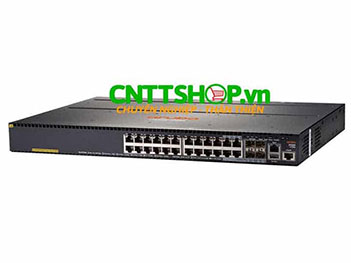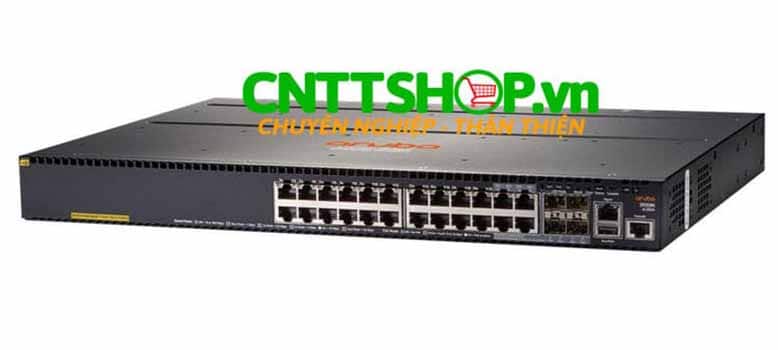| Software-defined networks |
Supports multiple programmatic interfaces, including
REST APIs, Openflow 1.0 and 1.3, and more, to enable automation of network operations, monitoring, and troubleshooting. |
| Unified Wired and Wireless |
- Supports unified wired and wireless policies using Aruba ClearPass Policy Manager
- Switch auto-configuration automatically configures switch settings such as VLAN, CoS, PoE max power, and PoE priority when an Aruba access point is detected.
- User Role defines a set of switch-based policies in areas such as security, authentication, and QoS. A user role can be assigned to a group of users or devices, using switch-based local user role or download from ClearPass.
- Dynamic segmentation provides a secured tunnel to transport network traffic on a per-port or per-user-role basis to an Aruba Controller. In per-user-role Tunneled Node, users are authenticated with ClearPass Policy Manager which can direct the traffic to be tunneled to Aruba controller or switch locally
|
| Quality of Service (QoS) |
- Traffic prioritization (IEEE 802.1p) for real-time classification into eight priority levels mapped to eight queues
- Layer 4 prioritization based on TCP/ UDP port numbers
- Class of Service (CoS) sets the IEEE 802.1p priority tag based on IP address, IP Type of Service (ToS), Layer 3 protocol, TCP/UDP port number, source port, and DiffServ
- Rate limiting sets per-port ingress enforced maximums and per-port, per-queue minimums
- Large buffers provide graceful congestion management
- Unknown Unicast Rate Limiting throttles unicast packets with unknown destination addresses and limits flooding on the VLAN
|
| Connectivity |
- HPE Smart Rate multi-gigabit (IEEE 802.3bz) Ethernet supports high-speed wireless access points
- Flexible configurations include:
- Switch with 24 Smart Rate ports
- Switch with 40 gigabit ports and 8 Smart Rate ports
- Switch with 24 Smart Rate ports supporting high power IEEE 802.3bt Class 6 (60W)
- Switch with 40 gigabit ports and 8 Smart Rate ports supporting high power IEEE 802.3bt Class 6 (60W)
- All 2930M switches support optional 4 port Smart Rate module
- Flexible 10 Gb/s Ethernet connectivity Modular 4 port 10 Gigabit (SFP+) available
- Models with IEEE 802.3bt Class 6 PoE provides up to 60 W per port for IEEE 802.3bt compatible devices.
- 40Gbps Uplink port connectivity Modular 40Gbps QSFP+ port available
- Auto-MDIX provides automatic adjustments for straight-through or crossover cables on all 10/100 and 10/100/1000 ports
- IEEE 802.3at Power over Ethernet (PoE+) provides up to 30 W per port that allows support of the latest PoE+-capable devices such as IP phones, wireless access points, and security cameras, as well as any IEEE 802.3af-compliant end device; eliminates the cost of additional electrical cabling and circuits that would otherwise be necessary in IP phone and WLAN deployments
- Pre-standard PoE support detects and provides power to pre-standard PoE devices
- IPv6
- IPv6 host enables switches to be managed in an IPv6 network
- Dual stack (IPv4 and IPv6) transitions from IPv4 to IPv6, supporting connectivity for both protocols
- MLD snooping forwards IPv6 multicast traffic to the appropriate interface
- IPv6 ACL/QoS supports ACL and QoS for IPv6 network traffic
- IPv6 routing supports static and RIPng and OSPFv3 protocols
- Security provides RA guard, DHCPv6 protection, dynamic IPv6 lockdown, and ND snooping
|
| Performance and Efficiency |
- Energy-efficient design
- 80 PLUS Gold and Platinum Certified power supplies increase power efficiency and savings
- Energy-efficient Ethernet (EEE) support reduces power consumption in accordance with IEEE 802.3az
- Designed with the latest Aruba Provision ASIC, providing very low latency, increased packet buffering, and adaptive power consumption
- Selectable queue configurations allows for increased performance by selecting the number of queues and associated memory buffering that best meet the requirements of the network applications
- Stacking Topology
- High Performance stacking—up to 100 Gbps of stacking throughput per switch. Each 2-port stacking module can support up to 25Gbps in each direction per port.
- Ring topology—Supports up to 10 member stack
- Virtualized Switching provides simplified management as the switches act as a single chassis when stacked
|
| Convergence |
- IP multicast snooping and data-driven IGMP automatically prevent flooding of IP multicast traffic
- LLDP-MED (Media Endpoint Discovery) defines a standard extension of LLDP that stores values for parameters such as QoS and VLAN to configure automatically network devices such as IP phones
- IEEE 802.1AB Link Layer Discovery Protocol (LLDP) facilitates easy mapping using network management applications with LLDP automated device discovery protocol
- PoE and PoE+ allocations support multiple methods (automatic, IEEE 802.3at dynamic, LLDP-MED fine grain, IEEE 802.3af device class, or user-specified) to allocate and manage PoE/PoE+ power for more efficient energy savings
- PoE Class 6 allocations support increased dynamic power up to 60W with new IEEE 802.3bt LLDP type, length, and value (TLV) information extended to 29 octets
- Local MAC Authentication assigns attributes such as VLAN and QoS using locally configured profile that can be a list of MAC prefixes
- IP multicast routing includes PIM sparse and dense modes to route IP multicast traffic
- Protocol Independent Multicast for IPv6 supports one-to-many and many-to-many media casting use cases such as IPTV over IPv6 networks
|
| Resiliency and high availability |
- Virtual Router Redundancy Protocol (VRRP) allows groups of two routers to back each other up dynamically to create highly available routed environments in IPV4 and IPV6 networks
- IEEE 802.1s Multiple Spanning Tree provides high link availability in multiple VLAN environments by allowing multiple spanning trees; provides legacy support for IEEE 802.1d and IEEE 802.1w
- IEEE 802.3ad link-aggregation-control protocol (LACP) and port trunking supports up to 26 static and dynamic trunks with each trunk having up to eight links (ports) per static trunk
- SmartLink provides easy-to-configure link redundancy of active and standby links
- Dual hot-swappable power supplies: Increased Resiliency provides secondary power supply to enable complete switch power redundancy in case or power line or supply failure
|
| Simplified Configuration and Management |
- Aruba Central cloud- based management platform offers simple, secure and cost effective way to manage switches
- Zero-Touch-Provisioning (ZTP) simplifies installation of the switch infrastructure using Aruba Activate or DHCP-based process with AirWave and Central Network Management
- Flexible management with same hardware - Supports both cloud-based Central and on-premise AirWave with the same hardware ensuring change management platform without ripping and replacing switching infrastructure
- Built-in programmable and easy to use REST API interface provides configuration automation for campus networks
- Out-of-band Ethernet management port enables management on a separate physical management network, and keeps management traffic segmented from network data traffic
- SNMPv1, v2, and v3 provide complete support of SNMP; provide full support of industry-standard Management Information Base (MIB) plus private extensions; SNMPv3 supports increased security using encryption
|
| Manageability |
- Dual flash images provides independent primary and secondary operating system files for backup while upgrading
- Friendly port names allow assignment of descriptive names to ports
- Find-Fix-Inform feature finds and fixes common network problems automatically, then informs administrator
- Supports multiple configuration files to be stored to a flash image
- RMON, XRMON, and sFlow provide advanced monitoring and reporting capabilities for statistics, history, alarms, and events
- Troubleshooting ingress and egress port monitoring enable network problem solving
- Unidirectional link detection (UDLD) monitors the link between two switches and blocks the ports on both ends of the link if the link goes down at any point between the two devices
- Power down mode delivers power savings by allowing the switch to power down most of the switch, except a clock which will boot up the switch when scheduled.
|
| Layer 2 switching |
- IEEE802.1ad QinQ: Increases the scalability of an Ethernet network by providing a hierarchical structure; connects multiple LANs on a high-speed campus or metro network
- VLAN Support and Tagging supports IEEE 802.1Q (4094 VLAN IDs) and 2K VLANs simultaneously
- Jumbo packet support improves the performance of large data transfers; supports frame size of up to 9220 bytes
- IEEE 802.1v protocol VLANs isolate select non-IPv4 protocols automatically into their own VLANs
- Rapid Per-VLAN Spanning Tree (RPVST+) allows each VLAN to build a separate spanning tree to improve link bandwidth usage; is compatible with PVST+
- GVRP and MVRP allows automatic learning and dynamic assignment of VLANs
- VxLAN encapsulation (tunneling) protocol for overlay network that enables a more scalable virtual network deployment
- IEEE 1588v2 Transparent Clock Mode1-step and end to end delay mode support critical timing Applications
|
| Layer 3 |
- DHCP server centralizes and reduces the cost of IPv4 address management
- Static IP routing provides manually configured routing; includes ECMP capability
- Routing Information Protocol (RIP) provides RIPv1, RIPv2, and RIPng routing
- Access OSPF provides OSPFv2 and OSPFv3 protocols for routing between access and the next layer on the LAN. One OSPF area and up to eight interfaces are supported.
- Policy-based routing uses a classifier to select traffic that can be forwarded based on policy set by the network administrator (limited to 16 next-hop routes)
|
| Security |
- Multiple user authentication methods
- Uses an IEEE 802.1X supplicant on the client in conjunction with a RADIUS server to authenticate in accordance with industry standards
- Supports web-based authentication provides a browser-based environment, similar to IEEE 802.1X, to authenticate clients that do not support IEEE 802.1X
- Supports MAC-based client authentication
- TPM-based Security: Includes a Trusted Platform Module (TPM) for secure hardware-based generation and storage of cryptographic keys that can be used for a variety of authentication purposes
- Authentication flexibility
- Multiple IEEE 802.1X users per port provides authentication of multiple devices on a single port; prevents a user from "piggybacking"? on another user's IEEE 802.1X authentication
- Concurrent IEEE 802.1X, Web, and MAC authentication schemes per port switch port will accept up to 32 sessions of IEEE 802.1X, Web, and MAC authentications
- Open authentication role simplifies first-time deployment of AAA in brownfield deployments by allowing full network access for failed clients and provides instant connectivity as soon as a client is plugged-in
- Critical authentication role ensures that important infrastructure devices such as IP phones are allowed network access even in the absence of a RADIUS server
- MAC pinning allows non-chatty legacy devices to stay authenticated by pinning client MAC addresses to the port until the clients logoff or get disconnected
- Access control lists (ACLs) provide IP Layer 3 filtering based on source/destination IP address/subnet and source/destination TCP/UDP port number
- Control plane policing: Set rate limit on control protocols to protect CPU overload
- Source-port filtering allows only specified ports to communicate with each other
- RADIUS/TACACS+ eases switch management security administration by using a password authentication server
- Secure shell encrypts all transmitted data for secure remote CLI access over IP networks
- Secure Sockets Layer (SSL) encrypts all HTTP traffic, allowing secure access to the browser-based management GUI in the switch
- Port security allows access only to specified MAC addresses, which can be learned or specified by the administrator
- MAC address lockout prevents particular configured MAC addresses from connecting to the network
- Secure FTP allows secure file transfer to and from the switch; protects against unwanted file downloads or unauthorized copying of a switch configuration file
- Switch management logon security helps secure switch CLI logon by optionally requiring either RADIUS or TACACS+ authentication
- Custom banner displays security policy when users log in to the switch
- STP BPDU port protection blocks Bridge Protocol Data Units (BPDUs) on ports that do not require BPDUs, preventing forged BPDU attacks
DHCP protection blocks DHCP packets from unauthorized DHCP servers, preventing denial-of-service attacks
- Dynamic ARP protection blocks ARP broadcasts from unauthorized hosts, preventing eavesdropping or theft of network data
- STP root guard protects the root bridge from malicious attacks or configuration mistakes
- Identity-driven ACL enables implementation of a highly granular and flexible access security policy and VLAN assignment specific to each authenticated network user
- Per-port broadcast throttling configures broadcast control selectively on heavy traffic port uplinks
- Private VLAN provides network security by restricting peer-to-peer communication to prevent a variety of malicious attacks; typically a switch port can only communicate with other ports in the same community and/or an uplink port, regardless of VLAN ID or destination MAC address
- IEEE 802.1AE MACsec provides security on a link between two switch ports (1Gbps or 10Gbps or HPE Smart Rate) using standard encryption and authentication
|
 Switch
Switch Wifi - Access Point
Wifi - Access Point Firewall
Firewall Router
Router Module Quang
Module Quang![Module Quang Cisco]() Module Quang Cisco
Module Quang Cisco![Module quang HPE]() Module quang HPE
Module quang HPE![Module quang Maipu]() Module quang Maipu
Module quang Maipu![Module quang Brocade]() Module quang Brocade
Module quang Brocade![Module quang Fortinet]() Module quang Fortinet
Module quang Fortinet![Module quang Aruba]() Module quang Aruba
Module quang Aruba![Module quang OEM]() Module quang OEM
Module quang OEM![Module quang Juniper]() Module quang Juniper
Module quang Juniper![Module quang Dell]() Module quang Dell
Module quang Dell![Module quang Palo Alto]() Module quang Palo Alto
Module quang Palo Alto![Module quang Huawei]() Module quang Huawei
Module quang Huawei![Module quang Arista]() Module quang Arista
Module quang Arista![Module quang F5]() Module quang F5
Module quang F5![Module quang H3C]() Module quang H3C
Module quang H3C![Module Quang Allied Telesis]() Module Quang Allied Telesis
Module Quang Allied Telesis![Module quang SonicWall]() Module quang SonicWall
Module quang SonicWall![Module quang Mikrotik]() Module quang Mikrotik
Module quang Mikrotik![Module quang Handar]() Module quang Handar
Module quang Handar Máy chủ (Server)
Máy chủ (Server) Thiết bị lưu trữ (SAN, NAS)
Thiết bị lưu trữ (SAN, NAS) Load Balancing
Load Balancing Video Conferencing
Video Conferencing Phụ kiện máy chủ
Phụ kiện máy chủ Thiết Bị IoT
Thiết Bị IoT Phụ Kiện Mạng
Phụ Kiện Mạng




.png)

























Bạn đang cần tư vấn về sản phẩm: JL320A ?
Cảm ơn bạn đã tin tưởng và sử dụng sản phẩm của chúng tôi.
Với những sản phẩm do CNTTShop phân phối sẽ được hỗ trợ cài đặt cơ bản nhé bạn.
Thiết bị mạng Aruba JL320A Sw bên Cnttshop bảo hành 12 tháng lỗi 1 đổi 1.
Nhân viên kinh doanh CNTTSHOP đã gửi báo giá Switch Aruba JL320A 2930M qua mail, bạn check Ibox.
datasheet của dòng sản phẩm Aruba Switch 2960M đã gửi qua mail, bạn check ibox nhé.